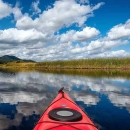Auto Tour Route Closed to Vehicles
The Auto Tour Route will be closed to vehicle traffic until further notice. Walkers, skiers, and snow shoers are welcome! 1 December 2025
Big Stone National Wildlife Refuge was originally purchased by the U.S. Army Corps of Engineers and was transferred to the U.S. Fish and Wildlife Service on May 21, 1975. The refuge currently includes 11,586 acres in Big Stone and Lac qui Parle Counties, in Minnesota.
Visit Us
The Auto Tour Route is open the first Monday in April to the first Monday in December unless otherwise noted in the alerts on our Home Page.
Connect with your natural heritage as you experience wildlife, diverse habitats and magnificent granite outcrops at Big Stone National Wildlife Refuge.




